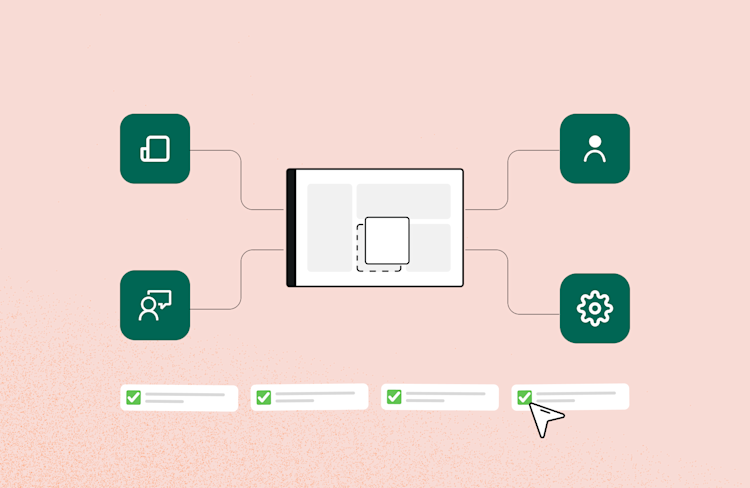The Definitive Guide to Web Conferencing
Looking for a web conferencing tool for the first time or need to replace your existing solution? This guide to web conferencing has everything you need.
Driven by the new normal, businesses across the world have been exploring new tools to connect digitally and collaborate virtually when meeting face-to-face simply isn’t an option.
Chat in Slack, hold a video conference over Whereby, share mind maps in Miro, manage tasks in Asana. In many cases, a lot of these team collaboration tools were already in use pre-pandemic, but took off significantly as more businesses moved to remote and digital-first.
As the name implies, web conferencing is the art of connecting people over the web in real-time.
Web conferencing tools use technology such as video, audio, and chat to connect people and recreate that conference room experience – virtually.
Now, maybe you’re exploring how to chart a path towards choosing the best web conferencing tool for your company, or perhaps you’re trying to figure out an alternative to what you’re already using.
In this article, we’ll explore the dynamics of web conferencing, touching on:
The key differences between web conferencing and video conferencing
Features an ideal web conferencing provider should offer
A snapshot of the best web conferencing tools
Keep scrolling for more on web conferencing.
Web conferencing vs. video conferencing: Are they the same?
On the surfrace, it’s easy to think web conferencing and video conferencing are one in the same. When you think of both solutions, it’s easy to imagine a screen filled with squares of your teammates’ faces connecting in an online meeting over video.
As it turns out, not quite. So what is web conferencing?
Web conferencing encompasses everything that goes into connecting people virtually over the internet for an online meeting, by recreating the in-person conference atmosphere via video, audio, and instant messaging.
A video conference, on the other hand, is just one of the components that makes up the web conferencing experience.
Features to consider when choosing a web conferencing solution
Given the variety of options available, choosing a web meeting provider can be a tall order to navigate, especially if you’re responsible for choosing web conferencing software for a large organization with diverse online meeting needs and use cases – and a team spread around the globe.
To start, you’ll need to define the functionality you want out of a web conferencing solution and opt for the platform that gives you the best combination of your desired features and pricing.
Here’s a list of the features to look out for when shopping for a web conferencing provider.
Video capability
Audio
Chat + emoji reactions
Pricing
Meeting recording functions
Technical simplicity
Screen sharing
Customer support
Security
Video capability
“Can you see me now? Oh, wait. Let me… quickly… hop into settings and see what’s wrong with my camera.”
Sound familiar? You’re not alone.
Video is the defining feature of web conferencing. And by that, we mean a clear, two-way solution that connects multiple users as simply as possible. So, whenever video is compromised, it affects the entire web conferencing experience and hinders effective communication.
An ideal web conferencing solution should be able to stream low latency video from multiple parties and maintain quality over differing broadband speeds so that teams can stay connected – from anywhere in the world.
Audio
Ever been on a call where the person on the other end looked great on screen, but audio lagged severely?
Or perhaps it was on your end? You check your internet speed and you’re clocking >50 Mbps, so what could be wrong?
You decide to just deal with it and continue your meeting with the audio a few seconds behind.
Right behind video, great audio serves as a must-have tool since it bridges the gap and helps everyone on your team share ideas as seamlessly as possible.
Chat + emoji reactions
Great video and audio form the foundation of good web conferencing, but there are situations where you need something more. Chat and emoji reactions come in handy in situations when you want to share a link or when a colleague is making a great point and you just want to send them a thumbs up rather than jumping in to speak.
Great chat and emoji reactions add another channel you can leverage to communicate alongside the in-person video and audio experience – and it brings the feel of an in-person, face-to-face meeting online.
Pricing
Unless you have an unlimited IT budget, pricing is one of those areas you need to keep an eye out for when you’re shopping for a web conferencing solution.
A great web conferencing app should offer a workable free version you can test out to get a feel of the entire product suite before committing to a long-term purchase.
Meeting recording functions
Recording gives you an avenue to manage knowledge flexibly.
Maybe you don’t have your head in the game at the moment, or you just want to review a conference later to grab insights post-meeting?
One-click meeting recording gives everyone looped in an easy avenue to save knowledge and consume it when it works best for them.
Technical simplicity
Anyone who’s used a traditional web conferencing solution knows the struggle of opening the app when you’re one minute late to a meeting, only to have to download and install updates.
That’s not how it should work. The more seamless (read: web-only) a video conferencing tool is, the more efficiently you can use it to connect with your team.
Screen sharing
Whether you’re meeting with two or 20 people, screen sharing offers a powerful context-sharing tool for engagement that shows everyone your perspective with minimal friction.
In the end, showing > telling.
Customer support
The quality of customer support a web conference tool comes with goes a long way to determining how useful that too. lis. Whether you’re trying out a new feature or reporting a bug, great customer support guarantees that even if issues come up, they'll be fixed quickly.
Security
Early last year, the world was shocked when bombing web conferencing rooms became a trend. Hackers and malcontents would hijack video conference rooms and loop in inappropriate videos or harass participants without warning.
Fast-forward a year later and there’s a bug that lets hackers take over your Mac via your local video conference app.
An ideal web conferencing solution should be designed to process and manage your private data securely.
Top 5 Best Web Conferencing Tools
Now we know what to look for in a great web conferencing tool, let’s explore some options.
Whereby
We designed Whereby as the solution for businesses and creatives who want web conferencing that just works.
Whereby simplifies the web conferencing experience so you can create or join meetings with one click.
Since it’s built on the cloud, you don’t have to install or update anything to run secure meetings that host up to 100 users. Whereby is designed to accommodate varying bandwidth speeds and render audio and video both ways with low latency. Plus it includes aspects like custom branding, waiting rooms, chat and emoji reactions, and more to help combat what’s known as video or Zoom fatigue.
Zoom
Zoom’s biggest weakness is the technical complexity it requires to start. To use Zoom, you’ll need to create an account, install a local application, and manage periodic updates to keep using the product.
Beyond that and Zoom’s less-than-perfect privacy record, Zoom offers low latency video and audio across multiple platforms so you’re always connected wherever and on whatever device choose.
Google Meet
Google Meet is Google’s web conferencing solution that’s free for up to 100 users, limited to 60 minutes per meeting.
As an improvement on alternatives like Zoom, Google Meet is based completely on the cloud and lets you start meetings with one click.
But Meet is best for users already familiar with Google’s suite of productivity tools. Accessing it otherwise will be cumbersome.
Slack
Slack offers a limited web conferencing solution for one-on-one video calling, built on top of their collaboration solution.
But, if you’re not already using Slack, it’s going to be unsustainable jumping in and out of the product just to use the video conferencing feature when there are better standalone alternatives.
BlueJeans
Powered by telecom giant Verizon, BlueJeans is another web conferencing solution for one-on-one and one-to-many meetings across a wide range of scenarios, from daily standups to webinars.
Users can create meetings right from the web portal and have invitees connect to meetings from their web browser.
But BlueJeans severely limits free functionality to a 7-day trial and unless you’ll be using it extensively across your team, it’s hard to justify the price for such basic functionality.
Web conferencing that works how and when you need it to
Whereby offers teams of all sizes a streamlined web conferencing experience, with features like:
One-click access via your web browser and a meeting room link that never changes
No access codes required to join meetings
Chat and emoji reaction functionality
Screen sharing
Branded waiting and meeting rooms to customize your web conferencing experience
Secure, privacy-minded solutions
Third-party integrations with your existing tech stack, including Trello, Outlook, and Miro
Low latency video and audio across all platforms
Whereby removes the headaches associated with traditional web conferencing platforms.
But don’t take our word for it.





